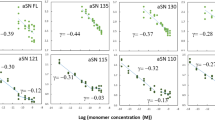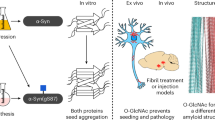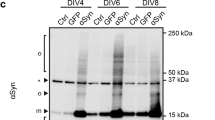Abstract
Polyglutamine (polyQ) diseases are classified as conformational neurodegenerative diseases, like Alzheimer and Parkinson diseases, and they are caused by proteins with an abnormally expanded polyQ stretch. However, conformational changes of the expanded polyQ protein and the toxic conformers formed during aggregation have remained poorly understood despite their important role in pathogenesis. Here we show that a β-sheet conformational transition of the expanded polyQ protein monomer precedes its assembly into β-sheet–rich amyloid-like fibrils. Microinjection of the various polyQ protein conformers into cultured cells revealed that the soluble β-sheet monomer causes cytotoxicity. The polyQ-binding peptide QBP1 prevents the toxic β-sheet conformational transition of the expanded polyQ protein monomer. We conclude that the toxic conformational transition, and not simply the aggregation process itself, is a therapeutic target for polyQ diseases and possibly for conformational diseases in general.
This is a preview of subscription content, access via your institution
Access options
Subscribe to this journal
Receive 12 print issues and online access
$189.00 per year
only $15.75 per issue
Buy this article
- Purchase on Springer Link
- Instant access to full article PDF
Prices may be subject to local taxes which are calculated during checkout






Similar content being viewed by others
References
Ross, C.A. & Poirier, M.A. Opinion: what is the role of protein aggregation in neurodegeneration? Nat. Rev. Mol. Cell Biol. 6, 891–898 (2005).
Carrell, R.W. & Lomas, D.A. Conformational disease. Lancet 350, 134–138 (1997).
Soto, C. Protein misfolding and disease; protein refolding and therapy. FEBS Lett. 498, 204–207 (2001).
Caughey, B. & Lansbury, P.T. Protofibrils, pores, fibrils, and neurodegeneration: separating the responsible protein aggregates from the innocent bystanders. Annu. Rev. Neurosci. 26, 267–298 (2003).
Stefani, M. & Dobson, C.M. Protein aggregation and aggregate toxicity: new insights into protein folding, misfolding diseases and biological evolution. J. Mol. Med. 81, 678–699 (2003).
Gusella, J.F. & MacDonald, M.E. Molecular genetics: unmasking polyglutamine triggers in neurodegenerative disease. Nat. Rev. Neurosci. 1, 109–115 (2000).
Zoghbi, H.Y. & Orr, H.T. Glutamine repeats and neurodegeneration. Annu. Rev. Neurosci. 23, 217–247 (2000).
Perutz, M.F., Johnson, T., Suzuki, M. & Finch, J.T. Glutamine repeats as polar zippers: their possible role in inherited neurodegenerative diseases. Proc. Natl. Acad. Sci. USA 91, 5355–5358 (1994).
Chen, S., Berthelier, V., Hamilton, J.B., O'Nuallain, B. & Wetzel, R. Amyloid-like features of polyglutamine aggregates and their assembly kinetics. Biochemistry 41, 7391–7399 (2002).
Scherzinger, E. et al. Huntingtin-encoded polyglutamine expansions form amyloid-like protein aggregates in vitro and in vivo. Cell 90, 549–558 (1997).
Bevivino, A.E. & Loll, P.J. An expanded glutamine repeat destabilizes native ataxin-3 structure and mediates formation of parallel β-fibrils. Proc. Natl. Acad. Sci. USA 98, 11955–11960 (2001).
Tanaka, M., Morishima, I., Akagi, T., Hashikawa, T. & Nukina, N. Intra- and intermolecular β-pleated sheet formation in glutamine-repeat inserted myoglobin as a model for polyglutamine diseases. J. Biol. Chem. 276, 45470–45475 (2001).
Nagai, Y. et al. Inhibition of polyglutamine protein aggregation and cell death by novel peptides identified by phage display screening. J. Biol. Chem. 275, 10437–10442 (2000).
Nagai, Y. et al. Prevention of polyglutamine oligomerization and neurodegeneration by the peptide inhibitor QBP1 in Drosophila. Hum. Mol. Genet. 12, 1253–1259 (2003).
Sanchez, I., Mahlke, C. & Yuan, J. Pivotal role of oligomerization in expanded polyglutamine neurodegenerative disorders. Nature 421, 373–379 (2003).
Colby, D.W. et al. Potent inhibition of huntingtin aggregation and cytotoxicity by a disulfide bond-free single-domain intracellular antibody. Proc. Natl. Acad. Sci. USA 101, 17616–17621 (2004).
Cummings, C.J. et al. Chaperone suppression of aggregation and altered subcellular proteasome localization imply protein misfolding in SCA1. Nat. Genet. 19, 148–154 (1998).
Warrick, J.M. et al. Suppression of polyglutamine-mediated neurodegeneration in Drosophila by the molecular chaperone HSP70. Nat. Genet. 23, 425–428 (1999).
Arrasate, M., Mitra, S., Schweitzer, E.S., Segal, M.R. & Finkbeiner, S. Inclusion body formation reduces levels of mutant huntingtin and the risk of neuronal death. Nature 431, 805–810 (2004).
Kopito, R.R. Aggresomes, inclusion bodies and protein aggregation. Trends Cell Biol. 10, 524–530 (2000).
Trottier, Y. et al. Polyglutamine expansion as a pathological epitope in Huntington's disease and four dominant cerebellar ataxias. Nature 378, 403–406 (1995).
Popiel, H.A. et al. Disruption of the toxic conformation of the expanded polyglutamine stretch leads to suppression of aggregate formation and cytotoxicity. Biochem. Biophys. Res. Commun. 317, 1200–1206 (2004).
Sreerama, N. & Woody, R.W. A self-consistent method for the analysis of protein secondary structure from circular dichroism. Anal. Biochem. 209, 32–44 (1993).
Kayed, R. et al. Common structure of soluble amyloid oligomers implies common mechanism of pathogenesis. Science 300, 486–489 (2003).
Sanbe, A. et al. Reversal of amyloid-induced heart disease in desmin-related cardiomyopathy. Proc. Natl. Acad. Sci. USA 102, 13592–13597 (2005).
Sharma, D., Sharma, S., Pasha, S. & Brahmachari, S.K. Peptide models for inherited neurodegenerative disorders: conformation and aggregation properties of long polyglutamine peptides with and without interruptions. FEBS Lett. 456, 181–185 (1999).
Altschuler, E.L., Hud, N.V., Mazrimas, J.A. & Rupp, B. Random coil conformation for extended polyglutamine stretches in aqueous soluble monomeric peptides. J. Pept. Res. 50, 73–75 (1997).
Masino, L., Kelly, G., Leonard, K., Trottier, Y. & Pastore, A. Solution structure of polyglutamine tracts in GST-polyglutamine fusion proteins. FEBS Lett. 513, 267–272 (2002).
Bhattacharyya, A. et al. Oligoproline effects on polyglutamine conformation and aggregation. J. Mol. Biol. 355, 524–535 (2006).
Lathrop, R.H., Casale, M., Tobias, D.J., Marsh, J.L. & Thompson, L.M. Modeling protein homopolymeric repeats: possible polyglutamine structural motifs for Huntington's disease. Proc. Int. Conf. Intell. Syst. Mol. Biol. 6, 105–114 (1998).
Richardson, J.S. & Richardson, D.C. The de novo design of protein structures. Trends Biochem. Sci. 14, 304–309 (1989).
Zagorski, M.G. & Barrow, C.J. NMR studies of amyloid β-peptides: proton assignments, secondary structure, and mechanism of an α-helix → β-sheet conversion for a homologous, 28-residue, N-terminal fragment. Biochemistry 31, 5621–5631 (1992).
Nguyen, J., Baldwin, M.A., Cohen, F.E. & Prusiner, S.B. Prion protein peptides induce α-helix to β-sheet conformational transitions. Biochemistry 34, 4186–4192 (1995).
Gross, M. Proteins that convert from α helix to β sheet: implications for folding and disease. Curr. Protein Pept. Sci. 1, 339–347 (2000).
Kelly, J.W. The alternative conformations of amyloidogenic proteins and their multi-step assembly pathways. Curr. Opin. Struct. Biol. 8, 101–106 (1998).
Serpell, L.C. Alzheimer's amyloid fibrils: structure and assembly. Biochim. Biophys. Acta 1502, 16–30 (2000).
Cohen, F.E. & Prusiner, S.B. Pathologic conformations of prion proteins. Annu. Rev. Biochem. 67, 793–819 (1998).
Harper, J.D. & Lansbury, P.T., Jr. Models of amyloid seeding in Alzheimer's disease and scrapie: mechanistic truths and physiological consequences of the time-dependent solubility of amyloid proteins. Annu. Rev. Biochem. 66, 385–407 (1997).
Poirier, M.A. et al. Huntingtin spheroids and protofibrils as precursors in polyglutamine fibrilization. J. Biol. Chem. 277, 41032–41037 (2002).
Yang, W., Dunlap, J.R., Andrews, R.B. & Wetzel, R. Aggregated polyglutamine peptides delivered to nuclei are toxic to mammalian cells. Hum. Mol. Genet. 11, 2905–2917 (2002).
Pike, C.J., Burdick, D., Walencewicz, A.J., Glabe, C.G. & Cotman, C.W. Neurodegeneration induced by β-amyloid peptides in vitro: the role of peptide assembly state. J. Neurosci. 13, 1676–1687 (1993).
Klein, W.L., Stine, W.B., Jr. & Teplow, D.B. Small assemblies of unmodified amyloid β-protein are the proximate neurotoxin in Alzheimer's disease. Neurobiol. Aging 25, 569–580 (2004).
Selkoe, D.J. Folding proteins in fatal ways. Nature 426, 900–904 (2003).
Bucciantini, M. et al. Inherent toxicity of aggregates implies a common mechanism for protein misfolding diseases. Nature 416, 507–511 (2002).
Taylor, B.M. et al. Spontaneous aggregation and cytotoxicity of the β-amyloid Aβ1–40: a kinetic model. J. Protein Chem. 22, 31–40 (2003).
Reixach, N., Deechongkit, S., Jiang, X., Kelly, J.W. & Buxbaum, J.N. Tissue damage in the amyloidoses: transthyretin monomers and nonnative oligomers are the major cytotoxic species in tissue culture. Proc. Natl. Acad. Sci. USA 101, 2817–2822 (2004).
Schaffar, G. et al. Cellular toxicity of polyglutamine expansion proteins: mechanism of transcription factor deactivation. Mol. Cell 15, 95–105 (2004).
Wanker, E.E. Protein aggregation in Huntington's and Parkinson's disease: implications for therapy. Mol. Med. Today 6, 387–391 (2000).
Bates, G. Huntingtin aggregation and toxicity in Huntington's disease. Lancet 361, 1642–1644 (2003).
Heiser, V. et al. Identification of benzothiazoles as potential polyglutamine aggregation inhibitors of Huntington's disease by using an automated filter retardation assay. Proc. Natl. Acad. Sci. USA 99 Suppl 4, 16400–16406 (2002).
Acknowledgements
We thank J.R. Burke, W.J. Strittmatter, O. Onodera and H. Hiramatsu for helpful discussions, H. Matsushima, R. Sasaki, C. Ito, M. Sakai, A. Fukuhara, Y. Okamoto, T. Saiwaki, T. Sekimoto and Y. Yoneda for technical assistance, K. Akao (JASCO) for the FT-IR measurements and R. Hirota (RIBM) for the AFM image recordings. This work was supported in part by Grants-in-Aid for Scientific Research on Priority Areas (to Y.N.; Advanced Brain Science Project, Research on Pathomechanisms of Brain Disorders, Life of Proteins, and Water and Biomolecules) and the 21st Century COE program (to T.T.) from the Ministry of Education, Culture, Sports, Science, and Technology, Japan; by Grants-in-Aid for Scientific Research (to Y.N. and T.I.) from the Japan Society for the Promotion of Science; and by a Grant-in-Aid for the Research Committee for Ataxic Diseases (to Y.N.) from the Ministry of Health, Labor and Welfare, Japan.
Author information
Authors and Affiliations
Contributions
Y.N. and T.I. designed the research. Y.N., T.I., H.A.P. and N.F. performed the biochemical and cell culture experiments. K.H. and H.N. performed the EM experiments. Y.U. provided the CD spectropolarimeter. Y.G. performed the analytical ultracentrifugation experiments. Y.N., T.I. and T.T. wrote the paper.
Corresponding authors
Ethics declarations
Competing interests
The authors declare no competing financial interests.
Rights and permissions
About this article
Cite this article
Nagai, Y., Inui, T., Popiel, H. et al. A toxic monomeric conformer of the polyglutamine protein. Nat Struct Mol Biol 14, 332–340 (2007). https://doi.org/10.1038/nsmb1215
Received:
Accepted:
Published:
Issue Date:
DOI: https://doi.org/10.1038/nsmb1215
This article is cited by
-
Amyloid modifier SERF1a interacts with polyQ-expanded huntingtin-exon 1 via helical interactions and exacerbates polyQ-induced toxicity
Communications Biology (2023)
-
Exogenous polyserine and polyleucine are toxic to recipient cells
Scientific Reports (2022)
-
Conditioned medium from BV2 microglial cells having polyleucine specifically alters startle response in mice
Scientific Reports (2022)
-
Divergent CPEB prion-like domains reveal different assembly mechanisms for a generic amyloid-like fold
BMC Biology (2021)
-
Toxicity of internalized polyalanine to cells depends on aggregation
Scientific Reports (2021)



